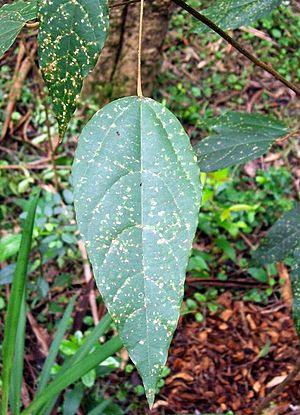Yellow kamala facts for kids
Quick facts for kids Yellow kamala |
|
|---|---|
 |
|
| Scientific classification | |
| Genus: |
Mallotus (plant)
|
| Species: |
discolor
|
| Synonyms | |
The Yellow Kamala (scientific name: Mallotus discolor) is a special tree found in the rainforests of Australia. It belongs to a plant family called the spurge family. People call it "Yellow Kamala" because its fruit has a yellowish-orange covering. This covering can even be used to make a yellow dye!
Contents
About the Yellow Kamala Tree
The Yellow Kamala is usually a small to medium-sized tree. It often grows to about 12 metres (39 ft) (around 40 feet) tall. But some very tall ones exist! For example, at Andrew Johnston Big Scrub Nature Reserve near Lismore, you can find a Yellow Kamala tree that is 30-metre-tall (98 ft). That's as tall as a 10-story building! Its trunk is also quite wide, about 50-centimetre-broad (20 in).
Another very tall tree, also 30-metre-tall (98 ft), grows at Susan Island Nature Reserve. This one has an even wider trunk, about 80-centimetre-broad (31 in).
You can find these trees growing naturally along the eastern coast of Australia. Their home stretches from near Coffs Harbour in northern New South Wales all the way up to Bowen, Queensland.
Tree Trunk and Branches
The trunk of the Yellow Kamala tree does not have large, wide supports (called buttresses) at its base. The bark on older trees might have some small cracks or scales, but it is generally quite smooth.
The smaller branches of the tree are thin. They can be green or brown. Towards their ends, they often have a reddish, hairy covering.
Leaves of the Yellow Kamala
The leaves of the Yellow Kamala tree have long stems, usually between 4 and 10 cm long. The leaves grow in an alternating pattern along the branch. They do not have jagged edges or "teeth."
The shape of the leaves is often like a spear (lanceolate) or oval (ovate), with a long, pointed tip. They are fairly thin and measure about 4 to 10 cm in length. The underside of the leaf is a greyish color, while the top surface is green and almost smooth. This difference in color on the top and bottom of the leaf is why the tree's scientific name is discolor, which means "two colors."
Life Cycle: Flowers, Fruit, and How it Grows
The Yellow Kamala tree produces grey flowers in November. These flowers grow on long clusters called racemes, which are about 7 to 10 cm long.
The fruit of the tree ripens in January. It is a soft, moist capsule with a yellowish-orange covering. This capsule is quite small, only about 6 mm across. Many animals enjoy eating this fruit, including the green catbird, Lewin's honeyeater, and the grey-headed flying fox.
It can be a bit tricky to grow new Yellow Kamala trees from fresh seeds. However, a good way to grow new trees is by using cuttings from an existing plant.

